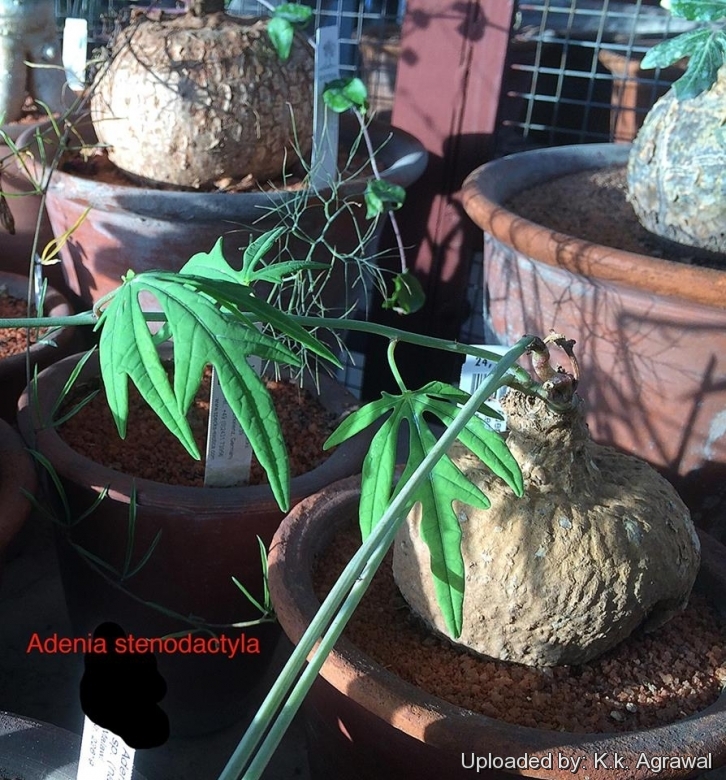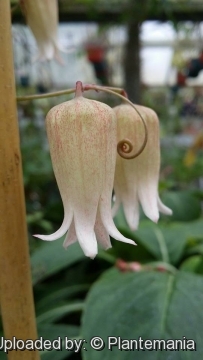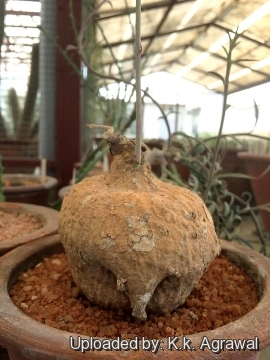
Adenia stenodactyla Photo by: K.k. Agrawal
Origin and Habitat: Tanzania (Ufipa, Dodoma and Songea Districts), Southern Kenya, Mozambique and Zambia
Type: Tanzania, Mbeya/Chunya Districts, Usafwa.
Altitude range: 900–2100 metres above sea level.
Habitat and ecology: Adenia stenodactylaSN|29953]]SN|29953]] grows in grassland, savannas, scrub, edges of woodlands, rocky hillsides on various types of soils.
Synonyms:
See all synonyms of Adenia stenodactyla
back
Accepted name in llifle Database:Adenia stenodactyla HarmsNotizbl. Bot. Gart. Berlin-Dahlem 8: 297 1923.Synonymy: 3
back
Description: Adenia stenodactylaSN|29953]]SN|29953]] is a monoecious (or rarely hermaphrodite), herbaceous climber to 2.5 m long, arising from a tuberous rootstock. The rootstok serves as a water reservoir in times of drought. Whole plant usually glabrous.
Caudex: Up to 30 centimetres in diameter.
Branches: Vine-like, greyish-glaucous, striate, herbaceous, arising in the summer, 50–250 cm in length, with internodes 2–10 cm long, straggling, trailing, creeping or climbing into the surrounding vegetation where they support themselves by means of tendrils. The basal parts sometimes ± woody. Sterile tendrils to 12 cm long, one per leaf or absent.
Leaves: Membranous, greyish green, sometimes with purplish spots beneath, 2-25 cm in diameter, very deeply 5-parted or 5-foliolate, leaflets oblong or linear, entire to deeply 3- to 8-lobed, margin entire; petiolules to 1.5 cm; petiole 0.5 - 5 cm; Glands at blade-base 2 (-4), lateral, separate or contiguous on a wart-like appendage at the tip of the petiole. Blade-glands (0–)2–4(–16), submarginal or partly scattered. Stipules linear, c. 1 mm long.
Inflorescences: Up to 10-flowered in female specimens, 1–3-flowered in males, with tendril 2-6 cm long. Peduncle 1 - 8 cm long.
Flowers: Often reddish veined or striped, sometimes bisexual.
Male flowers: Broadly tubular-urceolate, including stipe 25-40 mm long; hypanthium broadly cup-shaped more or less 5-saccate, 4-7 mm. Calyx tube 12-20 mm, lobes ovate-triangular, 4 - 8 mm, fringed. Petals oblong-spatulate, 6-10 mm long, edge fringed. Filaments 4-7.5 mm long, fused at the base of the hypanthium. Anthers 6-8 (-10) mm, obtuse. Corona consisting of slender sometimes branched hairs 0.5–1.5 mm long. Disk glands 3-3.5 mm.
Female flowers: Tubiform-campanulate, including the 2-3(-4) mm. long stipe 15-18. mm long. Ovary ellipsoid, c. 4 mm, 3-ribbed. Styles partly connate; Stigmas sessile, woolly-papillate 2 mm in diameter.
Hermaphrodite flowers: Resembling male flowers but with a well-developed pistil. .
Fruits (capsules): 1–2 per inflorescence, ellipsoid, excluding the 8–15 mm long gynophore (2.5–)3–6 by 2–3.5 cm.; pericarp coriaceous, red, (when dry) finely paler speckled.
Seeds: 40–60 per capsule, obovate, 5–6.5 mm.
Bibliography: Major references and further lectures
1) W. J. J. O. de Wildem (Rijksherbarium, Leiden) “Flora of Tropical East Africa” 1975
2) R. and A. Fernandes “Flora Zambesiaca” FZ, Vol 4, Part 0, page 368, 1978
3) Urs Eggli “Illustrated Handbook of Succulent Plants: Dicotyledons” Springer Science & Business Media, 2002
 Adenia stenodactyla Photo by: K.k. Agrawal
Adenia stenodactyla Photo by: K.k. Agrawal Adenia stenodactyla Photo by: © Plantemania
Adenia stenodactyla Photo by: © Plantemania ...looking like elephant head. Photo by: K.k. Agrawal
...looking like elephant head. Photo by: K.k. Agrawal Adenia stenodactyla Photo by: © Plantemania
Adenia stenodactyla Photo by: © PlantemaniaCultivation and Propagation: Adenia stenodactylaSN|29953]]SN|29953]] is an interesting addition to a collection, but rarely seen in cultivation. It can be grown outdoors in topical climates and forms an impenetrable shrub if not manicured.
Growth rate: It grows well, though very slowly, but it possible to increase the speed of growth to some extent by providing adequate amount of water, warmth, and fertilizer during the active growing season, but it’s susceptible to rotting if too wet.
Exposure: It needs light shade, but the caudex should be in the shade, while the leaves prefer some sun. Avoid direct blasting sun in summer. Bright light if grown indoors.
Soil: In pots it needs a very porous potting medium (add pumice, vulcanite, and perlite). It does better in a rather acidic soil.
Waterings: Water frequently while plant is in full growth, but keep dry during the winter after the branches have died back. It rot easily and do NOT like a lot of water when it has no leaves.
Fertilizer: Benefits from moderate doses of a well-balanced, slow-release fertilizer.
Frost tolerance: Due to its African origin keep warm in winter, the minimum safe average temperature is 15°C, although it can go lower for short periods. It can be grown outdoors in frost-free climates, need anyway to kept above 10°C and dry in winter. It is very prone to rot in cool, wet conditions. USDA Zone 10-12, but does very well in containers.
Manteinance: Repot every two years. It like pots with generous drain holes. In the winter, the vining branches die back and should be cut back to encourage branching, to maintain an attractive shape and to ensure caudex habit. If pruned and kept somewhat pot bound, it can be maintained at a manageable size, depending on what ''manageable size'' means to you.
Propagation: The species can be propagated by both seeds and cuttings. The plants for seed production are generally grown from cuttings since these bloom more freely. The plants for decoration are grown from seed since they develop a caudex.
Warning: As with all adenias, all parts of this plant are very toxic, and they should be handled with caution, particularly when pruning.














